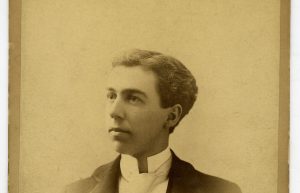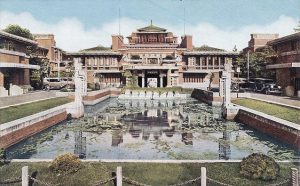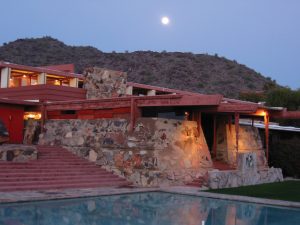When many hear the name Frank Lloyd Wright, they think of the innovative designer and architect who left his imprint on not just modern architecture but some of Arizona’s finest buildings. With over 10 buildings in the Phoenix area alone, it’s hard to ignore the influence Frank Lloyd Wright paved for creating masterpieces in the the Valley of the sun.
Born on June 9th, 1867, the famed designer, architect, writer and educator Franklin Lloyd Wright was born in Richland Center, Wisconsin as the oldest son of William Carey Wright and Anna Lloyd Jones with his two younger sisters.

Wright as a young pupil.
Frank Lloyd Wright’s inspiration began at an early age after his mother bought a set of educational blocks created by Friedrich Wilhelm August for her children to play with. These series of geometrically shaped blocks to which he assembled for hours helped ignite the young creative mind of Frank Lloyd Wright.
Wright went on to attend Madison high school and went to the University of Wisconsin-Madison in 1886. In order to pay his tuition fees, he assisted the architect Joseph Silsbee with the construction of the Unity Chapel which still stands to day. This experience motivated him to become an architect upon graduation from the university.

Wright as a university Student where he gained real world experience in the world of architecture.
Upon graduation Wright, re-located to Chicago in 1887 in search of work. He found work as a draftsman with the architectural firm of Joseph Silsbee with whom he had under his tutelage.
Wright eventually opened his own practice after leaving Sullivan. His first independent commission was the Winslow House in River Forest, Illinois which was characterized through expansive and open interior spaces. This design soon came to be called the “organic style” one Wright’s trademark styles.

The Winslow House in River Forest, Illinois.
Wright would soon go on to hone his skills and develop another architectural style that was uniquely American, designs used for several residential and public buildings over the next several years that came to be known as “prairie style.”
The prairie styled houses were known for their extended low buildings with shallow, sloping roofs, suppressed chimneys, and terraces. These houses serve an example of the “open plan”, featuring long and low windows that connect the interiors closer to nature.
After the Unitarian Temple in Chicago was burned down in 1905, Wright offered to build the Unity Temple on which he worked thrugh 1909. The temple was built with just reinforced concrete, and was hailed as one of the world’s first modern buildings.

Unitarian Temple in Chicago
As the 1920’s approached, Wright took on global projects when he was commissioned by the Japanese Government to design the Imperial hotel in Tokyo in 1915 which took took Wright a full seven years to build the project which he claimed was earthquake proof. The claim proved to be a fact as the hotel was the only large structure to survive the Great Kanto Earthquake of 1923.

The former ‘Imperial Hotel’ in Tokyo Japan. (Demolished in 1968)
As the great depression turned into full swing, Wright saw less projects coming his way and began focusing on writing going on to publish s books ‘An Autobiography’ and ‘The Disappearing City’ were published in 1932.
Nearing the mid-1930’s, Frank Lloyd Wright was growing weary of the harsh Wisconsin and Illinois winters.
Wright had been smitten with Arizona since his 1927 trip to Phoenix to consult on the Biltmore Hotel where he served as Master Architect.

Arizona Biltmore (Waldorf) Hotel in Phoenix, AZ.
Eventually, Wright went on to establish the Frank Lloyd Wright School of Architecture where he would make his winter home during the remaining years of his life.
Originally known as the Taliesin Fellowship, the “camp” of architects would blossom into on the six hundred acres Wright purchased in 1937 at the foothills of the McDowell Mountains in Scottsdale. A prestigious and selective school and estate which attracts thousands of visitors world wide to this day 80 years later.

Open to the public for tours, Taliesin West is located on Frank Lloyd Wright Boulevard in Scottsdale, Arizona, USA.
As the mid 1940’s approached and wars broke worldwide, Wright began his largest and longest tenured project through tasking 16 years from (1943-1959) to design the Solomon R. Guggenheim Museum in New York City which rises as a spiral with its interiors similar to the inside of a sea shell.

Solomon R. Guggenheim Museum in New York City, New York.
After a career that spanned over seven decades, Frank Lloyd Wright died in 1959 at his Phoenix estate at the age of 91. The same year Wright’s well known Gammage Auditorium which houses concerts, symphony and countless events throughout the year.
Today Wright’s legacy speaks through the designs alone who helped bring to life through Phoenix’s landscape and beyond.
Look for more local celebrities here!






